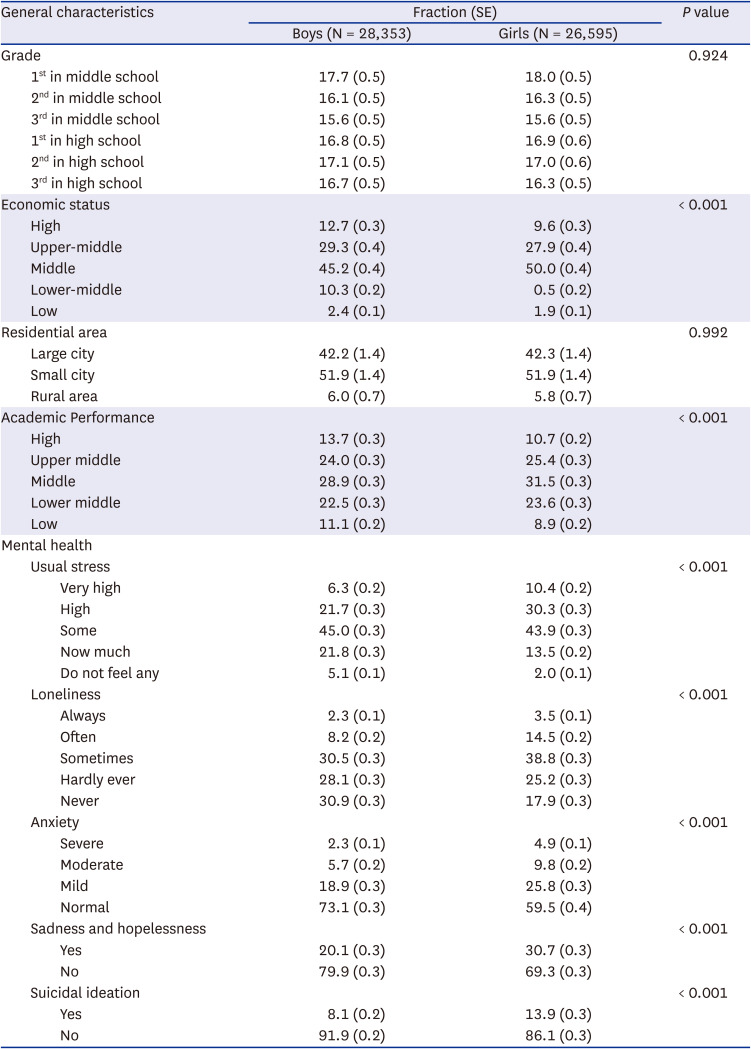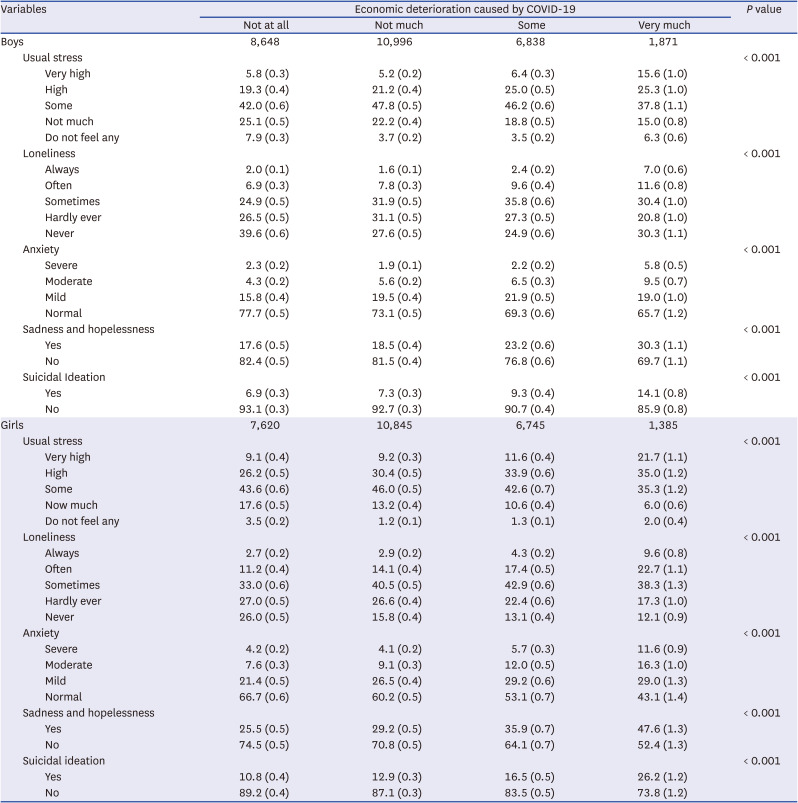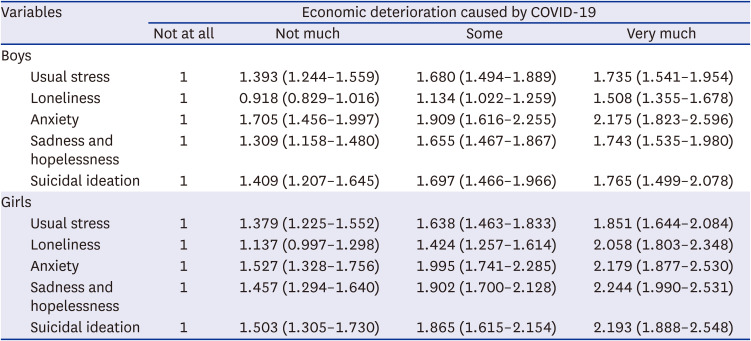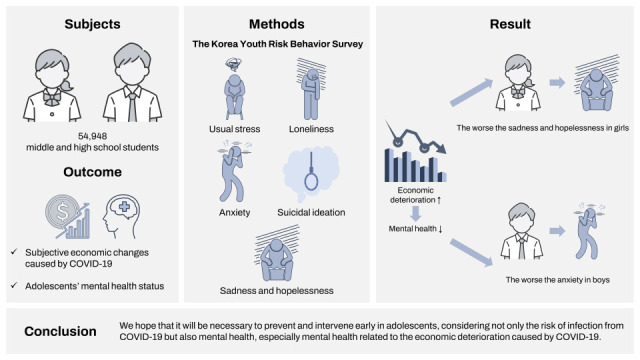1. Coronaviridae Study Group of the International Committee on Taxonomy of Viruses. The species severe acute respiratory syndrome-related coronavirus: classifying 2019-nCoV and naming it SARS-CoV-2. Nat Microbiol. 2020; 5(4):536–544. PMID:
32123347.
3. World Health Organization. WHO coronavirus (COVID-19) dashboard. Updated 2021. Accessed October 8, 2021.
https://covid19.who.int
.
6. Mantovani A, Rinaldi E, Zusi C, Beatrice G, Saccomani MD, Dalbeni A. Coronavirus disease 2019 (COVID-19) in children and/or adolescents: a meta-analysis. Pediatr Res. 2021; 89(4):733–737. PMID:
32555539.

7. Chen F, Zheng D, Liu J, Gong Y, Guan Z, Lou D. Depression and anxiety among adolescents during COVID-19: a cross-sectional study. Brain Behav Immun. 2020; 88:36–38. PMID:
32464156.

8. Zhou SJ, Zhang LG, Wang LL, Guo ZC, Wang JQ, Chen JC, et al. Prevalence and socio-demographic correlates of psychological health problems in Chinese adolescents during the outbreak of COVID-19. Eur Child Adolesc Psychiatry. 2020; 29(6):749–758. PMID:
32363492.

9. Ravens-Sieberer U, Kaman A, Erhart M, Devine J, Schlack R, Otto C. Impact of the COVID-19 pandemic on quality of life and mental health in children and adolescents in Germany. Eur Child Adolesc Psychiatry. 2022; 31(6):879–889. PMID:
33492480.

10. Lee H, Noh Y, Seo JY, Park SH, Kim MH, Won S. Impact of the COVID-19 pandemic on the mental health of adolescent students in Daegu, Korea. J Korean Med Sci. 2021; 36(46):e321. PMID:
34845877.

12. Aum S, Lee SY, Shin Y. COVID-19 doesn’t need lockdowns to destroy jobs: the effect of local outbreaks in Korea. Labour Econ. 2021; 70:101993. PMID:
34754143.

13. Gili M, Roca M, Basu S, McKee M, Stuckler D. The mental health risks of economic crisis in Spain: evidence from primary care centres, 2006 and 2010. Eur J Public Health. 2013; 23(1):103–108. PMID:
23132877.

14. Katikireddi SV, Niedzwiedz CL, Popham F. Trends in population mental health before and after the 2008 recession: a repeat cross-sectional analysis of the 1991–2010 Health Surveys of England. BMJ Open. 2012; 2(5):e001790.

15. Hong J, Knapp M, McGuire A. Income-related inequalities in the prevalence of depression and suicidal behaviour: a 10-year trend following economic crisis. World Psychiatry. 2011; 10(1):40–44. PMID:
21379355.

16. Kivimäki M, Batty GD, Pentti J, Shipley MJ, Sipilä PN, Nyberg ST, et al. Association between socioeconomic status and the development of mental and physical health conditions in adulthood: a multi-cohort study. Lancet Public Health. 2020; 5(3):e140–e149. PMID:
32007134.

17. Wadsworth ME, Achenbach TM. Explaining the link between low socioeconomic status and psychopathology: testing two mechanisms of the social causation hypothesis. J Consult Clin Psychol. 2005; 73(6):1146–1153. PMID:
16392987.

18. Kim Y, Choi S, Chun C, Park S, Khang YH, Oh K. Data Resource Profile: The Korea Youth Risk Behavior Web-based Survey (KYRBS). Int J Epidemiol. 2016; 45(4):1076–1076e. PMID:
27380796.

19. Spitzer RL, Kroenke K, Williams JB, Löwe B. A brief measure for assessing generalized anxiety disorder: the GAD-7. Arch Intern Med. 2006; 166(10):1092–1097. PMID:
16717171.

20. Lee HJ, Jung EH, Kim MK, Jeon JH. COVID-19 and Household Income Reduction in Korea. Sejong, Korea: KIHASA;2020. p. 26–30.
21. Loades ME, Chatburn E, Higson-Sweeney N, Reynolds S, Shafran R, Brigden A, et al. Rapid systematic review: the impact of social isolation and loneliness on the mental health of children and adolescents in the context of COVID-19. J Am Acad Child Adolesc Psychiatry. 2020; 59(11):1218–1239.e3. PMID:
32504808.

22. Ellis WE, Dumas TM, Forbes LM. Physically isolated but socially connected: Psychological adjustment and stress among adolescents during the initial COVID-19 crisis. Can J Behav Sci Rev Can Sci Comport. 2020; 52(3):177–187.

23. Lee J. Mental health effects of school closures during COVID-19. Lancet Child Adolesc Health. 2020; 4(6):421. PMID:
32302537.

24. Oosterhoff B, Palmer CA. Attitudes and psychological factors associated with news monitoring, social distancing, disinfecting, and hoarding behaviors among US adolescents during the coronavirus disease 2019 pandemic. JAMA Pediatr. 2020; 174(12):1184–1190. PMID:
32597925.

25. Gao J, Zheng P, Jia Y, Chen H, Mao Y, Chen S, et al. Mental health problems and social media exposure during COVID-19 outbreak. PLoS One. 2020; 15(4):e0231924. PMID:
32298385.

26. Chevance A, Gourion D, Hoertel N, Llorca PM, Thomas P, Bocher R, et al. Assurer les soins aux patients souffrant de troubles psychiques en France pendant l’épidémie à SARS-CoV-2. Encephale. 2020; 46(3):S3–13. PMID:
32312567.

27. Cortese S, Asherson P, Sonuga-Barke E, Banaschewski T, Brandeis D, Buitelaar J, et al. ADHD management during the COVID-19 pandemic: guidance from the European ADHD Guidelines Group. Lancet Child Adolesc Health. 2020; 4(6):412–414. PMID:
32311314.

28. Smile SC. Supporting children with autism spectrum disorder in the face of the COVID-19 pandemic. CMAJ. 2020; 192(21):E587–E587. PMID:
32575062.

29. Davis C, Ng KC, Oh JY, Baeg A, Rajasegaran K, Chew CS. Caring for children and adolescents with eating disorders in the current coronavirus 19 pandemic: a Singapore perspective. J Adolesc Health. 2020; 67(1):131–134. PMID:
32381385.

30. Fernández-Aranda F, Casas M, Claes L, Bryan DC, Favaro A, Granero R, et al. COVID-19 and implications for eating disorders. Eur Eat Disord Rev. 2020; 28(3):239–245. PMID:
32346977.
31. Charles KK, Decicca P. Local labor market fluctuations and health: is there a connection and for whom? J Health Econ. 2008; 27(6):1532–1550. PMID:
18653256.

32. Ruhm CJ. Healthy living in hard times. J Health Econ. 2005; 24(2):341–363. PMID:
15721049.

33. Ruhm CJ. Recessions, healthy no more? J Health Econ. 2015; 42:17–28. PMID:
25839783.

34. Stevens AH, Miller DL, Page ME, Filipski M. The best of times, the worst of times: understanding pro-cyclical mortality. Am Econ J Econ Policy. 2015; 7(4):279–311. PMID:
29973973.

35. Gassman-Pines A, Ananat EO, Gibson-Davis CM. Effects of statewide job losses on adolescent suicide-related behaviors. Am J Public Health. 2014; 104(10):1964–1970. PMID:
25122027.

36. Golberstein E, Gonzales G, Meara E. How do economic downturns affect the mental health of children? Evidence from the National Health Interview Survey. Health Econ. 2019; 28(8):955–970. PMID:
31165566.

37. Schaller J, Zerpa M. Short-run effects of parental job loss on child health. Am J Health Econ. 2019; 5(1):8–41.

38. Mihashi M, Otsubo Y, Yinjuan X, Nagatomi K, Hoshiko M, Ishitake T. Predictive factors of psychological disorder development during recovery following SARS outbreak. Health Psychol. 2009; 28(1):91–100. PMID:
19210022.

39. Paleologou MP, Anagnostopoulos DC, Lazaratou H, Economou M, Peppou LE, Malliori M. Adolescents’ mental health during the financial crisis in Greece: The first epidemiological data. Psychiatriki. 2018; 29(3):271–274. PMID:
30605432.

40. Lee SY, Hong JS, Espelage DL. An ecological understanding of youth suicide in South Korea. Sch Psychol Int. 2010; 31(5):531–546.








 PDF
PDF Citation
Citation Print
Print




 XML Download
XML Download